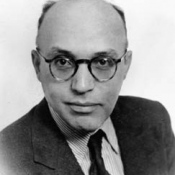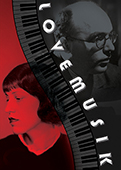Kurt Weill

Kurt Weill was born on 2 March 1900 in Dessau, Germany. The son of a cantor, Weill displayed musical talent early on: by the time he was twelve, he was composing and mounting concerts and dramatic works in the hall above his family’s quarters in the Gemeindehaus. During the years of the First World War, he accompanied opera singers at the Dessau Court Theater.
After studying theory and composition with Albert Bing, Kapellmeister of the Dessau Court Theater, Weill enrolled at the Berlin Hochschule fnr Musik, but found the conservative training under Engelbert Humperdinck stifling. After a season as a conductor of the newly formed municipal theater in Lindenscheid, he returned to Berlin and was accepted into Ferruccio Busoni’s master class in composition. He supported himself through a wide range of musical occupations, from playing organ in a synagogue to piano in a Bierkeller, by tutoring students (including Claudio Arrau and Maurice Abravanel) in music theory, and, later, by contributing music criticism to Der deutsche Rundfunk, the weekly program journal of the Berlin radio station, Funk-Stunde A-G.
Weill’s early works demonstrate the influence of Wagner, Reger, Mahler and Schoenberg. By 1925, a series of performances in Berlin and at international music festivals established Weill as one of the leading composers of his generation, along with Paul Hindemith and Ernst Krenek; and in 1926, at Dresden, he gained success in the theatre with his first opera, DER PROTAGONIST, a one-act piece on a text by Georg Kaiser. Weill considered Der Neue Orpheus (1925), a cantata for soprano, violin and orchestra, on a poem by Ivan Goll, to be a turning point in his career. This composition prefigured characteristics which were to coalesce into the pervasive duality and provocative ambiguity typical of his compositions. Modernist tendencies are most apparent in the one-act surrealist opera ROYAL PALACE (1926) on a libretto by Ivan Goll (exceptional in its incorporation of film and dance), and the opera buffa DER ZAR LÄSST SICH PHOTOGRAPHIEREN (1927) on a libretto by Georg Kaiser. By this time in his career, Weill’s use of dance idioms associated with American jazz and his pursuit of collaborations with the finest contemporary playwrights, with the express intention of reforming the musical stage, had become distinctive stylistic traits.
A commission from the Baden-Baden Music Festival in 1927 led to the creation of MAHOGONNY (SONGSPIEL), Weill’s first collaboration with Bertolt Brecht, whose radio production of Mann Ist Mann and whose poetry collection, Die Hauspostille, had captured Weill’s imagination and suggested Brecht as an individual with a compatible literary and dramatic sensibility. The succès|de scandale of MAHOGONNY encouraged Weill and Brecht to continue work on the full-length opera AUFSTIEG UND FALL DER STADT MAHOGONNY (given its premiere at Leipzig in March 1930). Exploiting a newly derived popular song-style, Weill and Brecht also wrote several works for singing actors in the commercial theater, including DIE DREIGROSCHENOPER and HAPPY END. They explored other alternatives to the opera establishment in the school-opera DER JASAGER and the radio cantatas DAS BERLINER REQUIEM and DER LINDBERGHFLUG. Increasingly uncomfortable with Brecht’s restriction of the role of music in his political theater, Weill turned to a new collaborator, the famous stage designer Caspar Neher, for the libretto of his last full-length opera, DIE BÜRGSCHAFT (1932), and again to Georg Kaiser for the daring play-with-music DER SILBERSEE (1932).
These later works (AUFSTIEG UND FALL DER STADT MAHOGONNY and DER SILBERSEE in particular) outraged the Nazis. Riots broke out at several performances and carefully orchestrated propaganda campaigns discouraged productions of his works; in March 1933, Weill fled Germany. In Paris, Weill completed his Second Symphony and renewed briefly his collaboration with Brecht for DIE SIEBEN TODSÜNDEN, a “ballet with singing” for George Balanchine’s company, “Les Ballets” (1933.) He also wrote a number of cabaret chansons, as well as the score for Jacques Deval’s Marie Galante. When a German-language premiere of his DER KUHHANDEL (libretto by Robert Vambery) seemed hopeless, Weill traveled to London for an ill-fated production of this operetta, which had been transformed into a British musical comedy and retitled A KINGDOM FOR A COW. In September 1935, Weill went to America to oversee Max Reinhardt’s production of Franz Werfel’s biblical epic DER WEG DER VERHEISSUNG, for which Weill had written an extensive oratorio-like score. After many delays, the work was finally staged in 1937 in truncated form as The Eternal Road.
Encouraged by his reception in the United States and convinced that the commercial theatre offered more artistic possibilities than did the conservative opera house, Weill turned to Broadway (and the politically committed theatre in America) with Johnny Johnson. During the next decade, he established himself as a new and original voice in the mainstream of American musical theatre. Yet KNICKERBOCKER HOLIDAY, LADY IN THE DARK, ONE TOUCH OF VENUS, STREET SCENE, LOVE LIFE and LOST IN THE STARS hardly represented conventional fare. Weill often asserted that his attempt to enlist leading dramatists for the cause of the musical theatre was no less successful in the United States than it had been in Germany, and his collaborators included Maxwell Anderson, Ira Gershwin, Moss Hart, Ogden Nash, S.J. Perelman, Langston Hughes, Elmer Rice, and Alan Jay Lerner. Weill also wrote film scores in Hollywood, an American school-opera with Arnold Sundgaard, DOWN IN THE VALLEY, as well as numerous other works. In addition, he served as a member of The Playwrights’ Company and The Dramatists’ Guild. During the war years, he was extremely active in artistic initiatives intended to foster morale and boost various war efforts. Weill died on April 3, 1950.
His death came at the time that his German works were beginning to be rediscovered. Yet, the resulting dichotomy of the “two Weills” has remained for posterity to resolve. Only now have we begun to come to grips with the remarkable range and endlessly fascinating variety of his works, which nevertheless always carry his unmistakable stylistic signature.
www.kwf.org
Alle musicals van Kurt Weill


